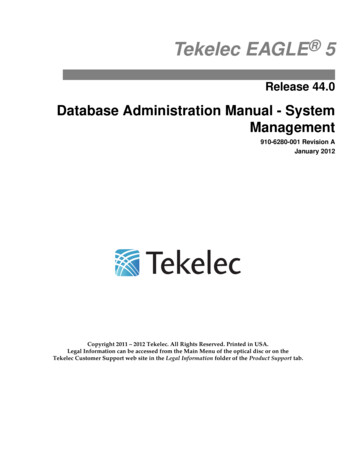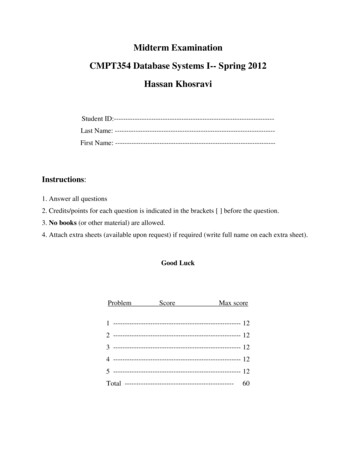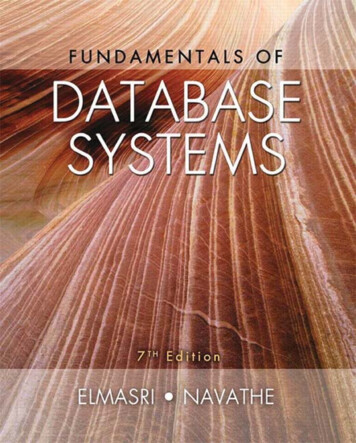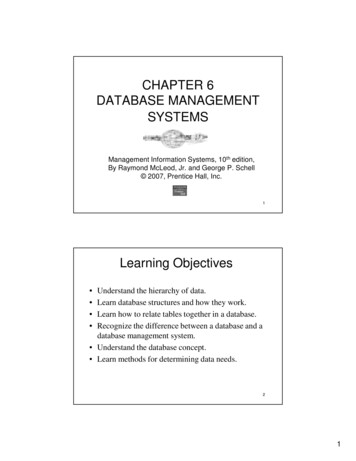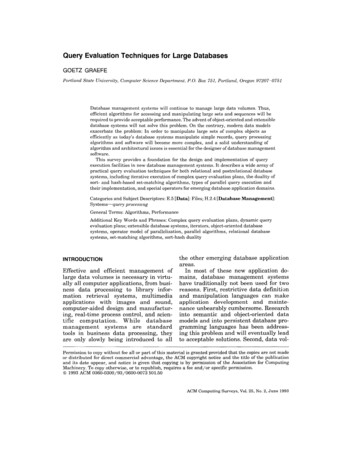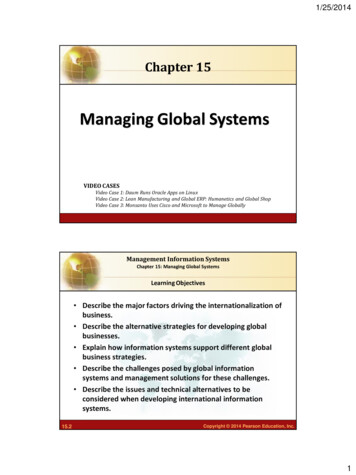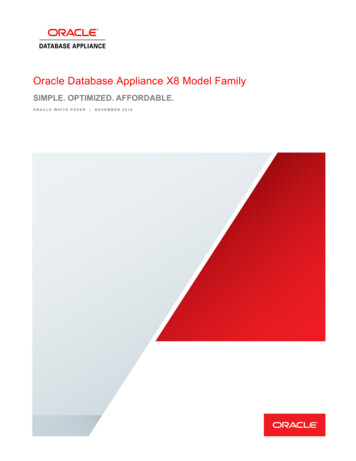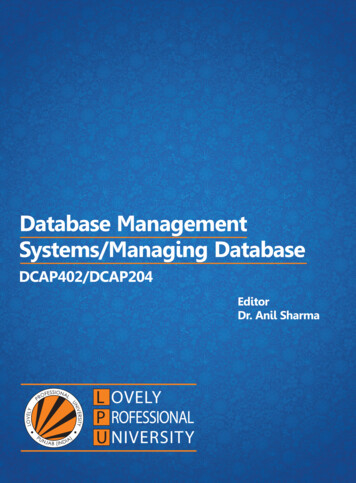
Transcription
Database ManagementSystems/Managing DatabaseDCAP402/DCAP204EditorDr. Anil Sharma
www.lpude.inDIRECTORATE OF DISTANCE EDUCATIONDATABASE MANAGEMENT SYSTEMS/MANAGING DATABASEEdited ByDr. Anil Sharma
ISBN: 978-93-87034-71-6Printed byEXCEL BOOKS PRIVATE LIMITEDRegd. Office: E-77, South Ext. Part-I, Delhi-110049Corporate Office: 1E/14, Jhandewalan Extension, New Delhi-110055 91-8800697053, celbooks.comforLovely Professional UniversityPhagwara
CONTENTSUnit 1:Database FundamentalsHarjinder Kaur, Lovely Professional University1Unit 2:Database Relational ModelPooja Gupta, Lovely Professional University12Unit 3:Structured Query LanguageSartaj Singh, Lovely Professional University37Unit 4:Advanced SQLSarabjit Kumar, Lovely Professional University59Unit 5:Integrity ConstraintsPawan Kumar, Lovely Professional University72Unit 6:Relational Language and Database DesignPawan Kumar, Lovely Professional University84Unit 7:Relational Database DesignMandeep Kaur, Lovely Professional University106Unit 8:NormalizationSahil Rampal, Lovely Professional University127Unit 9:Transaction ManagementPooja Gupta, Lovely Professional University148Unit 10:Datalog and RecursionMithilesh Kumar Dubey, Lovely Professional University166Unit 11:Recovery SystemBalraj Kumar, Lovely Professional University179Unit 12:Query Processing and OptimizationKamlesh Lakhwani, Lovely Professional University196Unit 13:Parallel DatabasesManmohan Sharma, Lovely Professional University219Unit 14:Application Development and AdministrationManmohan Sharma, Lovely Professional University232
SYLLABUSDatabase Management Systems/Managing DatabaseObjectives: The course aims at providing the students through insight on database management principles and practices. Themajor objectives of the course are to: Knowledge of DBMS and in terms of use and design Describe the main features and function of the DBMS; Describe the features of relational database and E-R models; Experience with SQL queries; Experience ER diagrams; Discuss the concept of Transaction, Recovery, Concurrency and Security of DBMSDCAP402 Database Management SystemsSr. No.Description1.Database Fundamentals: Database systems, Database Architecture Relational Model, Structure of Relationaldatabases, fundamental, additional and extended relational algebra operations2.SQL: Data Definition, datatypes, schema definition, Basic structure of SQL Queries, Creating tables, DMLoperations, DDL commands for creating and altering, Set Operations, Aggregate Functions, NULL values3.Advanced SQL: Subqueries, Nested subqueries, Complex queries, Views, Joined relations, Integrityconstraints, Authorization, DCL Commands, Embedded SQL, Dynamic SQL4.Relational Languages: Tuple Relational calculus, Domain relational calculus, Query by Example Databasedesign and ER model: Overview of Design process, Entity relationship model, constraints, ER Diagrams, ERDesign issues, Weak entity sets, extended ER features5.Relational Database Design: Features, Atomic Domains and first normal form, Functionaldependency theory decomposition using functional dependencies, decomposition using Multivalueddependencies, database design process Normalization: 1NF, 2NF, 3NF, BCNF, 4NF, 5NF.6.Transaction Management: Concept of Transaction, Transaction State, Implementation of atomicity anddurability, concurrent execution, Serializability, Recoverability, Implementation of Isolation, testing forSerializability.n Concurrency Control: Lock based protocols, Timestamp based protocols, Validation basedprotocols, Deadlock handling, Insert and Delete operations, Weak levels of consistency7.Recovery system: Failure classification, storage structure, recovery and atomicity, log-based recovery,recovery with concurrent transactions, buffer management, failure with loss of non-volatile storage8.Query Processing: Overview, measures of query cost, selection operation, sorting, join operation, evaluationof expressions Query Optimization: Transformation of relational expressions, estimating statistics ofexpression results, Choice of evaluation plans9.Parallel Databases: I/O parallelism, Interquery parallelism, Intraquery parallelism, Intraoperationparallelism, Interoperation parallelism10.Application development and administration: web interfaces to databases, performance tuning
DCAP204 Managing DatabaseSr. No.Description1.Introduction to fundamentals of DBMS: Database applications, Purpose of database systems, Views of data,Database languages, Relational Databases, Database Design, Transaction Management2.Relational Databases: Relational Model, Structure of Relational databases, fundamental, additional andextended relational algebra operations, Null Values, Modification of database3.SQL: Data Definition, datatypes, schema definition, Basic structure of SQL Queries, Creating tables, DML SELECT, INSERT, DELETE and UPDATE operations, DDL commands4.SQL: Set Operations – UNION, INTERSECT, EXCEPT, Aggregate Functions, NULL values, Nestedsubqueries, Complex queries, Views, Joined relations Advanced SQL: Integrity constraints, Authorization:GRANT, REVOKE5.Relational Languages: Tuple Relational calculus, Domain relational calculus, Query by Example, Datalog6.Database design and ER model: Overview of Design process, Entity relationship model, constraints, ERDiagrams, ER Design issues, Weak entity sets, extended ER features7.Relational Database Design: Features, Atomic Domains and first normal form, Functional dependency theorydecomposition using functional dependencies, decomposition using Multivalued dependencies, More normalforms, database design process8.Transaction Management: Concept of Transaction, Transaction State, Implementation of atomicity anddurability, concurrent execution, Serializability, Recoverability, Implementation of Isolation, testing forSerializability9.Concurrency Control: Lock based protocols, Timestamp based protocols, Validation based protocols,Deadlock handling, Insert and Delete operations, Weak levels of consistency10.Recovery system: Failure classification, storage structure, recovery and atomicity, log-based recovery,recovery with concurrent transactions, buffer management, failure with loss of nonvolatile storage
Harjinder Kaur, Lovely Professional UniversityUnit 1: Database FundamentalsUnit 1: Database Database Management Systems (DBMS)1.2Database System Applications1.3Characteristics of the Database Approach1.4Advantages of DBMS1.5Disadvantages of DBMS1.6Database Architecture1.7Summary1.8Keywords1.9Self Assessment1.10 Review Questions1.11 Further ReadingsObjectivesAfter studying this unit, you will be able to: Define database management system Explain database system applications State the characteristics and the database approach Discuss the advantages and disadvantages of database Discuss the database architectureIntroductionThe information storage and retrieval has become very important in our day-to-day life. Theold era of manual system is no longer used in most of the places. For example, to book yourairline tickets or to deposit your money in the bank the database systems may be used. Thedatabase system makes most of the operations automated. A very good example for this is thebilling system used for the items purchased in a super market. Obviously this is done with thehelp of a database application package. Inventory systems used in a drug store or in amanufacturing industry are some more examples of database. We can add similar kind ofexamples to this list.Apart from these traditional database systems, more sophisticated database systems are used inthe Internet where a large amount of information is stored and retrieved with efficient searchengines. For instance, http://www.google.com is a famous web site that enables users to searchfor their favorite information on the net. In a database we can store starting from text data tovery complex data like audio, video, etc.LOVELY PROFESSIONAL UNIVERSITY1
Database Management Systems/Managing DatabaseNotes1.1 Database Management Systems (DBMS)A database is a collection of related data stored in a standard format, designed to be shared bymultiple users. A database is defined as “A collection of interrelated data items that can beprocessed by one or more application programs”.A database can also be defined as “A collection of persistent data that is used by the applicationsystems of some given enterprise”. An enterprise can be a single individual (with a smallpersonal database), or a complete corporation or similar large body (with a large shared database),or anything in between.Example: A Bank, a Hospital, a University, a Manufacturing company.DataData is the raw material from which useful information is derived. The word data is the pluralof Datum. Data is commonly used in both singular and plural forms. It is defined as raw facts orobservations. It takes variety of forms, including numeric data, text and voice and images. Datais a collection of facts, which is unorganized but can be made organized into useful information.The term Data and Information come across in our daily life and are often interchanged.Example: Weights, prices, costs, number of items sold etc.InformationData that have been processed in such a way as to increase the knowledge of the person who usesthe data. The term data and information are closely related. Data are raw material resources thatare processed into finished information products. The information as data that has been processedin such way that it can increase the knowledge of the person who uses it.In practice, the database today may contain either data or information.Data ProcessingThe process of converting the facts into meaningful information is known as data processing.Data processing is also known as information processing.MetadataData that describe the properties or characteristics of other data.Data is only become useful when placed in some context. The primary mechanism for providingcontext for data is Metadata. Metadata are data that describe the properties, or characteristics ofother data. Some of these properties include data definition, data structures and rules orconstraints. The Metadata describes the properties of data but do not include that data.It allows the database designer and users to understand what data Exit, what the data mean, andwhat the fine distinctions are between seemingly similar data items. The management of Metadatais at least as a crucial as meaning the associated data since data without clear meaning can beconfusing, misinterpreted or erroneous.2LOVELY PROFESSIONAL UNIVERSITY
Unit 1: Database FundamentalsNotes1.2 Database System ApplicationsDatabases are widely used. Here are some representative applications:1.Banking: For customer information, accounts, and loans, and banking transactions.2.Airlines: For reservations and schedule information. Airlines were among the first to usedatabases in a geographically distributed manner - terminals situated around the worldaccessed the central database system through phone lines and other data networks.3.Universities: For student information, course registrations, and grades.4.Credit card transactions: For purchases on credit cards and generation of monthlystatements.5.Telecommunication: For keeping records of calls made, generating monthly bills,maintaining balances on prepaid calling cards, and storing information about thecommunication networks.6.Finance: For storing information about holdings, sales, and purchases of financialinstruments such as stocks and bonds.7.Sales: For customer, product, and purchase information.8.Manufacturing: For management of supply chain and for tracking production of items infactories, inventories of items in warehouses / stores, and orders for items.9.Human resources: For information about employees, salaries, payroll taxes and benefits,and for generation of paychecks.1.3 Characteristics of the Database ApproachA shared collection of logically related data along with the description of the data that suits tothe needs of large enterprises.Figure 1.1: File System ApproachProgram-1data description-1File -1Program-2data description-2File - 2Program-3File - 3data description-3This unit describes the basic differences between the traditional way of processing, also called asfile processing, and the database method of processing the data. Every operating system providesusers to open, save, and close a file. The users can store appropriate information in these files.Take a look at the Figure 1.1 which shows the traditional file processing system that stores theprogram and data description in a file. The related information of a particular application isstored in various files named as File1, File2, etc., and these files are manipulated using Program1,Program2, etc. This is the method that was used in early days.LOVELY PROFESSIONAL UNIVERSITY3
Database Management Systems/Managing DatabaseNotesIt means that without a DBMS, the data will simply be dumped into one or more files. For anyupdation, the files need to be opened and manually search for the line or record, update and thensave the file. Now you can understand the difficulties involved in marinating this type ofinformation storage.Figure 1.2: Database ApproachApplication program -1with data semanticsDescriptionManipulationApplication program -2with data semanticsControlDatabase.Application program -3with data semanticsWith the advent of database systems, the file processing approach is no longer used. Now youcan observe with the Figure 1.2 that the database is in the disk which in turn is controlled by theDBMS. In this approach the Application Program-1 along with its data semantics, ApplicationProgram-2 along with its data semantics, etc., interact with the database where the actual dataand constraints are stored through the DBMS. The DBMS provides the necessary control andmanipulation software modules for these application programs to access the data stored in thedatabase.This way the applications are free from the system dependent code and achieve program-dataindependence.TaskFind out the various sources of database management system.Drawbacks of File Processing System1.Catalog: In DBMS, the database structure is stored in a catalog and it also contains thestorage details with constraints.The DMBS software must equally work with any number of database applications providedthe catalog contains the structure and other details of that application. In file processingthe data definition is part of the application program.Example: Record declaration in Pascal.Class or structure declaration in C .2.Program-data independence: In file processing, if changes are done in the structure of thefile, then we may require changing the program design that accesses it. In DBMS the accessprograms are written independent of any specific files. This is called as program-dataindependence.The DBMS stores the data in such a way that the user need not be aware of these details.This concept is called as data abstraction and it may also be called as conceptualrepresentation.4LOVELY PROFESSIONAL UNIVERSITY
Unit 1: Database Fundamentals3.Views: A database may have many users and each one may be interested on a particularview of the application. A view is conceptually a table, but the records of this table are notstored in the database.NotesExample: Consider the Student database in which we can think of two views:View 1: Students Grade in various courses. To obtain this information the tables Courseand Grade Report are to be joined and created as a view.View 2: If we want to know the Prerequisite Courses that a student needs to study, threetables are to be joined. These tables are nothing but Student, Section and Prerequisite.4.Sharing and Transaction processing: A DBMS must provide control for various userstrying to access the database.Example: Railway Reservation System with multiple counters.Whenever several users try to access the same application at the same time, we call thissituation as concurrent transaction processing. Generally, the concurrent access is achievedwith a simple Local Area Network (LAN). It is also possible to book railway tickets onlinei.e. through Internet.1.4 Advantages of DBMSOne of the main advantages of using a database management system is that the organization canexert via the DBA, centralized management and control over the data. The database administratoris the focus of the centralized control. If any application requiring a change in the structure of adata record, the DBA makes the necessary modifications, which do not affect other applicationsor users of the record in question.The following are the major advantages of using a Database Management System (DBMS):1.Reduction of Redundancies: Centralized control of data by the DBA avoids unnecessaryduplication of data and effectively reduces the total amount of data storage required. Italso eliminates the extra processing necessary to trace the required data in a large mass ofdata. Another advantage of avoiding duplication is the elimination of the inconsistenciesthat tend to be present in redundant data files.2.Data Independence and Efficient Access: Database application programs are independentof the details of auto representation and storage. In addition a DBMS provides efficientstorage and retrieval mechanisms, including support for very large files, index structuresand query optimization.3.Data Integrity: Centralized control can also ensure that adequate checks are incorporatedin the DBMS to provide data integrity, which means that the data contained in the databaseis both accurate and consistent. Therefore, data values being entered for storage could bechecked to ensure that they fall within a specified range and are of the correct format. Forexample, the value for the age of an employee may be in the range of 16 and 75. Also itshould be ensured that if there is a reference to certain object, that object must exist. In thecase of an automatic teller machine, for example a user is not allowed to transfer fundsfrom a nonexistent savings account to a checking account.4.Data Security: Confidential data must not be accessed by unauthorized persons. Differentlevels of security could be implemented for various types of data and operations.LOVELY PROFESSIONAL UNIVERSITY5
Database Management Systems/Managing DatabaseNotes5.Reduced Application Development Time: Since the DBMS provides several importantfunctions required by applications, such as concurrency control and crash recovery, highlevel query facilities, etc., only application-specific code needs to be written.6.Conflict Resolution: Since the database is under the control of the DBA, he should resolvethe conflicting requirements of various users and applications.The DBA chooses the best file structure and access method to get optimal performance forthe response-critical applications, while permitting less critical applications to continueto use the database, though with a relatively slower response.7.Data Administration: By providing common base for a large collection of data that isshared by several users, a DBMS facilitates maintenance and data administration tasks. Agood DBA can effectively ensure the fine-tuning, the data representation, periodic backupsetc.8.Concurrent Access and Crash Recovery: A DBMS supports the notion of a transaction andexecutes the actions of transactions in an interleaved fashion to obtain good performance,but schedules them in such a way as to ensure that conflicting operations are not permittedto proceed concurrently. Further, the DBMS maintains a continuous log of the changes tothe data, and if there is a system crash, it can restore the database to a transaction- consistentstate. That is, the actions of incomplete transactions are undone. Thus, if each completetransaction, executing alone, maintains the consistent of criteria, then the database stateafter recovery from a crash is consistent.TaskDiscuss, what are the advantages of oracle instead of access.1.5 Disadvantages of DBMSThe disadvantage of the DBMS system is overhead cost. The processing overhead introduced bythe DBMS to implement security, integrity, and sharing of the data causes a degradation of theresponse and throughput times. An additional cost is that of migration from a traditionallyseparate application environment to an integrated one.Even though centralization reduces duplication, the lack of duplication requires that the databasebe adequately backup so that in the case of failure the data can be recovered.Backup and recovery operations are complex in a DBMS environment, and this is an incrementin a concurrent multi-user database system. A database system requires a certain amount ofcontrolled redundancies and duplication to enable access to related data items.Centralization also means that the data is accessible from a single source, namely the database.This increases the potential severity of security breaches and disrupting of the operation of theorganization because of down times and failures.1.6 Database ArchitectureThe functional components of a database system can be broadly divided into query processorcomponents and storage manager components. The query processor includes:1.6DML Compiler: It translates DML statements in a query language into low-level instructionsthat the query evaluation engine understands.LOVELY PROFESSIONAL UNIVERSITY
Unit 1: Database Fundamentals2.Embedded DML Pre-compiler: It converts DML statements embedded in an applicationprogram to normal procedure calls in the host language. The pre-compiler must interactwith the DML compiler to generate the appropriate code.3.DDL Interpreter: It interprets DDL Stateline its and records them in a set of tables containingmetadata.4.Transaction Manager: Ensures that the database remains in a consistent (correct) statedespite system failures, and that concurrent transaction executions proceed withoutconflicting.5.File Manager: Manages the allocation of space on disk storage and the data structures usedto represent information stored on disk.6.Buffer Manager: Is responsible for fetching data from disk storage into main memory anddeciding what data to cache in memory.NotesAlso some data structures are required as part of the physical system implementation:1.Data Files: The data files store the database by itself.2.Data Dictionary: It stores metadata about the structure of the database, as it is usedheavily.3.Indices: It provides fast access to data items that hold particular values.4.Statistical Data: It stores statistical information about the data in the database. Thisinformation used by the query processor to select efficient ways to execute a query.Figure 1.3: Structure of DBMSApplication programmesAPPLICATIONPROGRAMSDBA staffDDLSTATEMENTSDDLcompilerCasual n-time database processorPRIVILEGEDCOMMANDSEPre compilerQueryA a managerRun-time database processorDExecutionConcurrency control/Backup/Recovery sub systemsStored databaseLOVELY PROFESSIONAL UNIVERSITY7
Database Management Systems/Managing DatabaseNotes Case StudyRequirements AnalysisThe owner of B&N has thought about what he wants and offers a concise summary:“I would like my customers to be able to browse my catalog of books and to place ordersover the Internet. Currently, I take orders over the phone. I have mostly corporatecustomers who call me and give me the ISBN number of a book and a quantity. I thenprepare a shipment that contains the books they have ordered. If I don’t have enoughcopies in stock, I order additional copies and delay the shipment until the new copiesarrive; I want to ship a customer’s entire order together. My catalog includes all the booksthat I sell. For each book, the catalog contains its ISBN number, title, author, purchaseprice, sales price, and the year the book was published. Most of my customers are regulars,and I have records with their name, address, and credit card number. New customers haveto call me first and establish an account before they can use my Web site.On my new Web site, customers should first identify themselves by their unique customeridentification number. Then they should be able to browse my catalog and to place ordersonline.”DBDudes’s consultants are a little surprised by how quickly the requirements phase wascompleted it usually takes them weeks of discussions (and many lunches and dinners) toget this done but return to their offices to analyze this information.1.7 Summary8 A database is a collection of persistent data that is used by the application system of someenterprise. The enterprise may be a Bank, a Hospital, an Educational Institution, a Library,etc. The word persistence means once the data of the database is accepted by the DBMS, it canthen be removed from the database only by some explicit request. It can not be deleted or modified because of some side effect just like the programminglanguage variables. There are several advantages of storing the data in database rather than storing it inoperating system files. An example, university database, to illustrate this concept wasdiscussed. In the DBMS environment we speak of many people. For example, the main people involvedare DBA, Database Designers, and various types of users. Though database approach has few disadvantages under some specific circumstances, theuse of database is indispensable. The major implications of database approach are: Potential for enforcing standards Reduced application development time Flexibility Economically viable Data integrity and securityLOVELY PROFESSIONAL UNIVERSITY
Unit 1: Database Fundamentals Database need not be used always. There are occasions where you manage your data without a database.Notes1.8 KeywordsData Abstraction: A database management system is a collection of interrelated files and a setof programs that allow users to access and modify these files. A major purpose of a databasesystem is to provide users with an abstract view of the data. This is called data abstraction.Data processing: The process of converting the facts into meaningful information is known asdata processing. Data processing is also known as information processing.Data: Data is the raw material from which useful information is derived.Database: A shared collection of logically related data along with the description of the data thatsuits to the needs of large enterprises.Metadata: Data that describe the properties or characteristics of other data.1.9 Self AssessmentChoose the appropriate answer:1.2.3.DBMS stands for:(a)Database Managerial System(b)Database Management System(c)Database Management Source(d)Development Management SystemData processing is also known as(a)Data programming(b)Data access(c)Information processing(d)Database sourcingDDL stands for(a)Data Development Language(b)Data Document Language(c)Document Definition Language(d)Data Definition LanguageFill in the blanks:4. provides fast access to data items that hold particular values.5.Data is commonly used in both singular and . forms.6.The term data and . are closely related.7.The primary mechanism for providing context for data is .LOVELY PROFESSIONAL UNIVERSITY9
Database Management Systems/Managing DatabaseNotes8.A . is conceptually a table, but the records of this table are not stored inthe database.9.In DBMS the access programs are written independent of any specific .10.In file processing the data definition is part of the . program.1.10 Review Questions1.Define database. Explain the concepts in database environment.2.List and explain various Database System Applications.3.What are the differences between File processing systems and DBMS?4.Write the advantages of DBMS.5.Write short notes on Disadvantages of Database Management System.6.What is Data independence? Explain the types of Data Independence.7.What are the database languages? Explain the various languages.8.What are the responsibilities of a DBA? List and explain them.9.What is the role of Data user? Explain the types of users.10.Explain the architecture of DBMS.11.Explain the components of DBMS.12.Write history of Database Systems.Answers: Self ation7.Metadata8.view9.files10.application1.11 Further ReadingsBooksC.J. Date, Introduction to Database Systems, Pearson Education.Elmasri Navrate, Fundamentals of Database Systems, Pearson Education.Martin Gruber, Understanding SQL, BPB Publication, New DelhiPeter Rob & Carlos Coronel, Database Systems Design, Implementation andManagement, 7th Edition.Raghurama Krishnan, Johannes Gehrke, Database Management Systems, 3rd Edition,Tata McGraw Hill.Silberschatz, Korth, Database System Concepts, 5th Edition, McGraw Hill.10LOVELY PROFESSIONAL UNIVERSITY
Unit 1: Database FundamentalsSIlberschatz-Korth-Sudarshan, Database System Concepts, 4th Edition, TataMcGraw HillNotesVai Occardi, Relational Database: Theory & Practice, BPB Publication, New DelhiOnline source.netLOVELY PROFESSIONAL UNIVERSITY11
Database Management Systems/Managing DatabaseNotesPooja Gupta, Lovely Professional UniversityUnit 2: Database Relational l Model2.1.1Relational Model Concepts2.1.2Alternatives to the Relational Model2.1.3Implementation2.1.4Application to Databases2.1.5SQL and the Relational Model2.1.6Set-theoretic FormulationAdditional and Extended Relational Algebr
Database Management Systems/Managing Database Notes 1.1 Database Management Systems (DBMS) A database is a collection of related data stored in a standard format, designed to be shared by multiple users. A database is defined as “A collection of interrelated data items th



